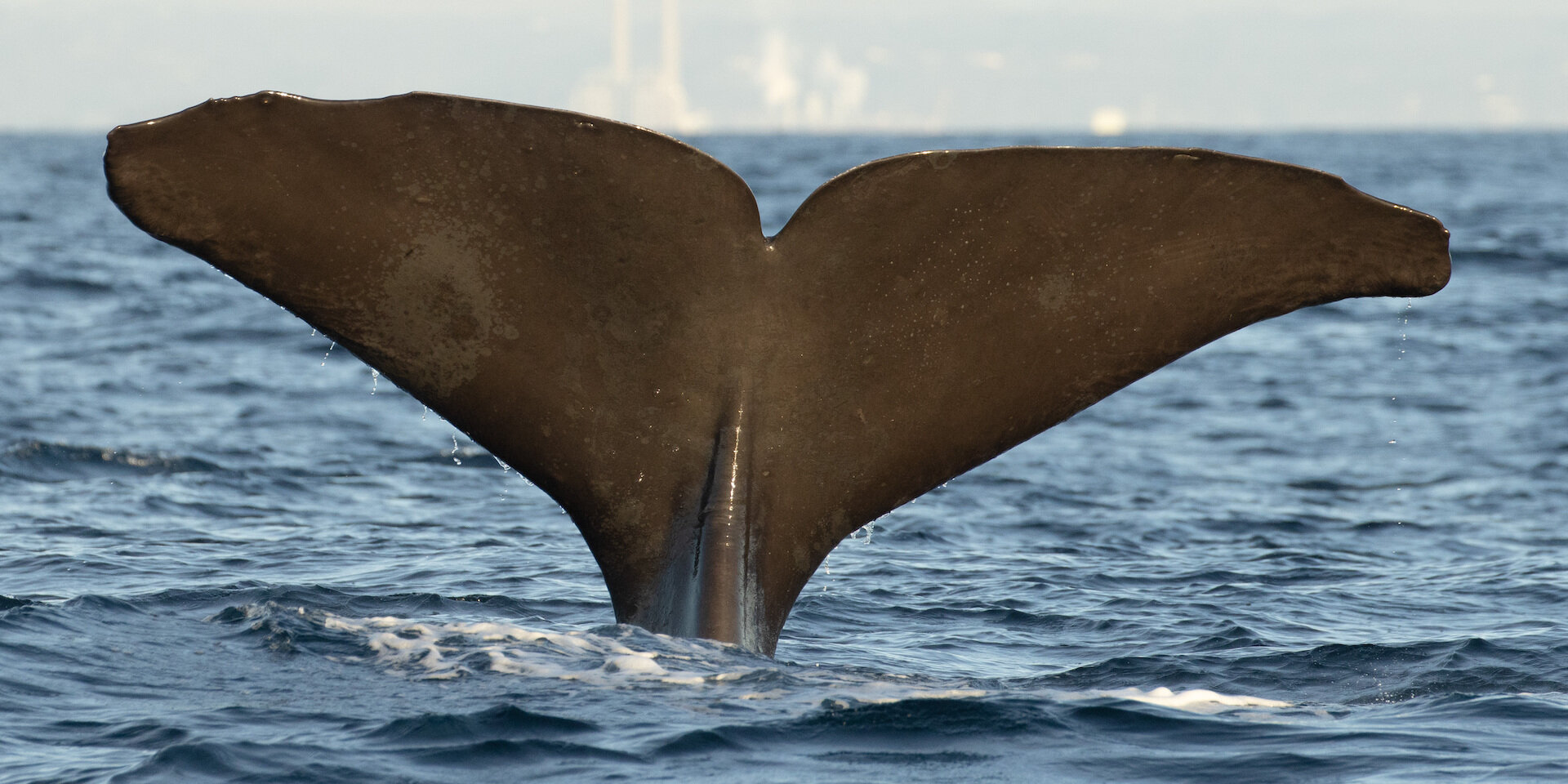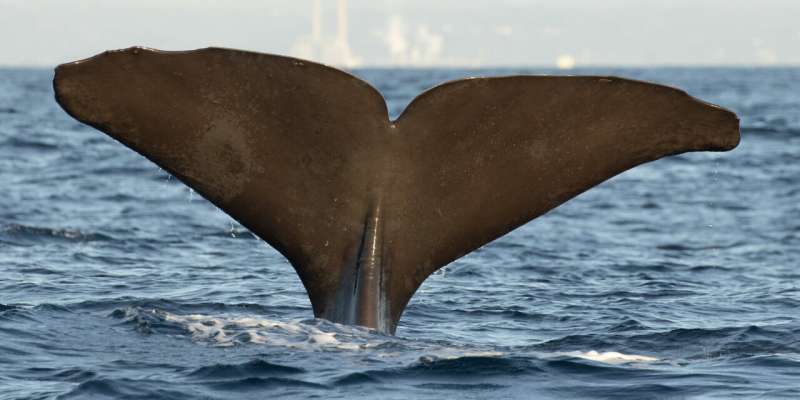

Sperm whales are the loudest animals on Earth and rely on sound to find food in the sprawling darkness of the deep sea. MBARI technology allows us to listen in, gaining new insight into the mysterious lives of these animals.
By reviewing seven years of acoustic data recorded in the Monterey Bay National Marine Sanctuary, MBARI researchers and collaborators from the Naval Postgraduate School and the University of Washington’s Center for Ecosystem Sentinels have discovered sperm whales are more common offshore of California than previously believed.
The researchers also learned that sperm whales are found in the Monterey Bay area more frequently during the winter, providing strong evidence for seasonal migrations in this species in the Northeast Pacific Ocean.
They published their findings on Sept. 24 in the journal Movement Ecology.
“Animals give us a window into their lives through the sounds that they make,” said Postdoctoral Fellow William Oestreich, who led this research. “Collecting acoustic data allows us to observe animal behavior, deepening our understanding of cryptic animals like sperm whales.
“Our findings provide new insight into sperm whale behavior and, by extension, seasonality in the deep sea, which can help inform protections for this endangered marine mammal and the ecosystems in which it feeds.”
Sperm whales (Physeter macrocephalus) can reach 16 meters (52 feet) in length and weigh up to 41 metric tons (45 tons). Despite their size, the lives of these important predators remain shrouded in mystery. Sperm whales dive hundreds to thousands of meters below the surface to feed on squid and fishes.
Much like bats echolocating in the night sky, sperm whales produce clicks to locate prey in the dark deep ocean. These loud and distinctive clicks give scientists the opportunity to study their behavior just by listening.
Sperm whale vocalizations contain rich information about who these animals are and what they are doing. Scientists can determine the age and sex of individuals from the interval between consecutive echolocation clicks. The sounds the whales make also provide clues about their behavior, like if they are searching for food or have successfully caught a meal.
MBARI has the unique capacity to collect continuous high-quality sound recordings in the deep sea over a long period of time. The institute’s cabled observatory, the Monterey Accelerated Research System (MARS), is located on the continental slope just outside Monterey Bay.
MARS allows researchers to test and deploy innovative new technology for studying the ocean and provides a platform for monitoring the ocean soundscape. A hydrophone, or underwater microphone, on the observatory records around-the-clock acoustic data from the heart of the Monterey Bay National Marine Sanctuary.
“To see a sperm whale or its unique sideways spout, we must be nearby on a boat. But underwater, we can hear the unique sound of a sperm whale’s echolocation from a hundred miles away,” explained biological oceanographer John Ryan, who leads MBARI’s Ocean Soundscape Team and coauthored the recent study.
“Because sound travels so powerfully underwater, listening greatly expands the reach of our senses. This reach enabled our first key discovery—that sperm whales, which are rarely seen in Monterey Bay National Marine Sanctuary, are continuously part of the region’s rich biodiversity.”
MBARI researchers developed an algorithm to detect the distinctive vocalizations of sperm whales in the trove of acoustic data recorded by the deep-sea hydrophone. Acoustic detection revealed that off the California coast, sperm whale vocalizations peak in the winter.
This is opposite a summer peak of sperm whale vocalizations previously reported by researchers in the Gulf of Alaska.
To understand the behaviors underlying the seasonal patterns in sperm whale vocalizations, MBARI researchers and their collaborators compared seven years of these acoustic detections with state-of-the-art simulations that incorporate data on well-understood movement strategies of other vertebrate species.
The team determined that the sperm whale acoustic patterns detected across different regions of the Northeast Pacific likely represent seasonal migratory movements. Previously, sperm whales were believed to be wandering nomads that opportunistically encountered food.
Sperm whale seasonality aligns with the latitude of the North Pacific Transition Zone (NPTZ). The NPTZ forms where cool subpolar waters meet warmer subtropical waters. A wide range of marine life feeds in this zone. The NPTZ shifts seasonally—it is farther south in the winter and farther north in the summer—mirroring sperm whale movements.
The seasonal peaks in sperm whale vocalizations are not as strong as surface-dwelling migratory animals, such as blue whales (Balaenoptera musculus). Without light and wind, deep-sea processes were historically thought to remain static throughout the year. However, biological connections link the surface to the deep.
The rain of organic material that feeds deep-sea animals and ecosystems changes with the seasons and annual blooms of productivity at the surface that trickle down to the depths below.
MBARI’s new research on sperm whales presents the strongest evidence yet that this top deep-sea predator undergoes seasonal migrations. The more subtle signal of sperm whale migrations reflects the overall dampened seasonality of the deep sea.
“The deep sea is challenging to study, yet we know the animals that live there play a vital role in the health of the planet. Whales store carbon in their bodies and transport nutrients deep in the water column, playing important roles in marine food webs and carbon transport.
“By listening to one of the deep ocean’s largest predators, we can learn about bigger patterns in deep-sea ecosystems,” said Senior Scientist Kelly Benoit-Bird, who leads MBARI’s Acoustical Ocean Ecology Team and was a co-author on the recent sperm whale study.
These findings can also help decision-makers implement protections for these endangered ocean giants and the environments they depend on.
“In order to manage human-wildlife interactions, we first need to understand where animals are and what they are doing. This study provides that important first step, unraveling the mysteries of this elusive ocean predator and helping to inform responsible stewardship,” said Oestreich.
Buried in hundreds of terabytes of continuous audio data that MBARI has recorded since 2015 are many more opportunities for important discoveries. MBARI shares this unique collection of data with a global community of researchers, policymakers, educators, and sound artists through its Open Data project on AWS.
More information:
William K. Oestreich et al, Evidence for seasonal migration by a cryptic top predator of the deep sea, Movement Ecology (2024). DOI: 10.1186/s40462-024-00500-x
Provided by
Monterey Bay Aquarium Research Institute
Citation:
Sound provides new information about the secret lives of sperm whales (2024, September 25)
retrieved 25 September 2024
from https://phys.org/news/2024-09-secret-sperm-whales.html
This document is subject to copyright. Apart from any fair dealing for the purpose of private study or research, no
part may be reproduced without the written permission. The content is provided for information purposes only.